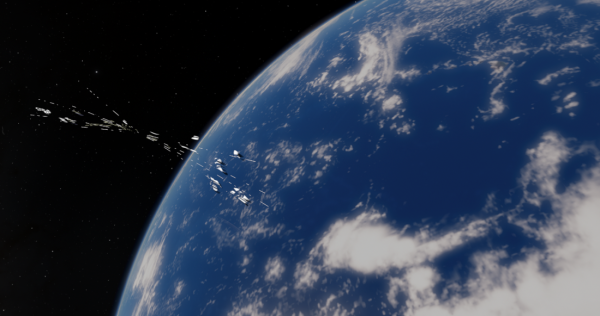BY LETTER
Kessler Syndrome
Technology > Technology Levels > Middle Tech / Midtech
Culture and Society > Politics & Government > Warfare
Culture and Society > Politics & Government > Warfare
 Image from Steve Bowers | |
| A Kessler Syndrome event in orbit around a Gaian world | |
The causes of Kessler syndrome are diverse, and may include malfunctioning restriction swarms, weapons designed to induce such an event, several unintended collisions in quick succession, or the overuse of orbital weaponry without sufficient orbital cleaning.
Kessler syndrome generally occurs more often in a planetary orbit due to the smaller volume involved. In orbit around a star it is much harder to induce Kessler syndrome due to the immense amount of orbital space available. Kessler syndrome is often a characteristic of a planetary orbit in a Cinder System.
First proposed by scientist Donald Kessler in the Late Atomic Age, originally referring to the chain reaction itself, but has now come to refer to the pollution of an orbit.
Military Applications of Kessler Syndrome
Kessler syndrome is often artificially induced during warfare or an operation to render an entire planet unreachable and its orbital space uninhabitable.Kessler syndrome can be induced using several methods:
- Orbital movement differences: Debris is introduced into orbit at varied speeds differing from that of the target or in the opposite orbital direction.
- Targeted object destruction: Orbital installations are destroyed in a manner that maximizes their fragmentation, either via specially targeted projectiles or weapons used onboard.
- Hijacked restriction swarm: A restriction swarm is hijacked and its components then open fire on each other, creating debris.
Countermeasures
Several countermeasures have been developed as a defense against Kessler syndrome. These include:- Anti-debris weaponry: The debris is vaporized entirely.
- Orbital manipulation: Using either a laser, electromagnetic tether, or attached thruster, the debris is maneuvered into a graveyard orbit, or de-orbited to either burn up in the atmosphere or crash into an unpopulated area of the planet.
- Collision avoidance: Thrusters are fired to avoid the debris collision altogether.
- Salvage: The debris is salvaged and its material used for other purposes.
- Resilience: Ships and orbital infrastructure are built to be capable of withstanding the impact force of the debris; in which case no action may be taken to avoid the collision.
Appears in Topics
Development Notes
Text by Lemuria
Initially published on 30 July 2022.
Initially published on 30 July 2022.
Additional Information
Additional information on Kessler Syndrome.






